![]()
![]()
![]()
Use LEFT and RIGHT arrow keys to navigate between flashcards;
Use UP and DOWN arrow keys to flip the card;
H to show hint;
A reads text to speech;
48 Cards in this Set
- Front
- Back
|
Describe direct and indirect discrimination and provide an example of each that may have been faced by a person with disability |
Direct discrimination is being treated lessfavourably, because of their disability, than a persona without that disabilitywould be treated in the same or similar circumstances. Discrimination against aperson personally (eg. not getting a job over an able bodied person) Indirect discrimination is when there is apractice or condition in place for all people which negatively impacts on aparticular group. This is unreasonable treatment which is less favourable inits impact. (eg. unable to access the front of a building because there is only stairs) |
|
|
Explain the DDA |
The Commonwealth Disability Discrimination Act(DDA) provides protection for everyone in Australia against discriminationbased on disability. It encourages everyone to be involved and toshare in the overall benefits to the community and the economy that flow fromparticipation by the widest range of people. |
|
|
Describe the social model of disability |
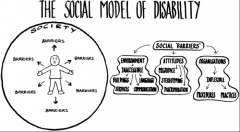
Highlights how society (environments, attitudes,and social structures) is disabling. The focus is on societal interactionsbetween environment and functional aspects and the consequences of impairmentsrather than on the body and its impairment. |
|
|
Describe the biomedical model of disability |
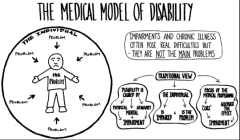
A fundamental starting point where the focus ison an individual’s functional limitations and their effect on daily life. Themodel’s aim is to prevent/minimize/cure these or, failing this, care for thedisabled person. |
|
|
Restrictions to the built environment can impact a person in many ways. Describe 5 examples of how the built environment could impact the participation of someone with a disability |
1. Signage: without clear signage, people with adisability would not know where the accessible ramps would be located or ifthere even was one. 2. Doorways: without adequate doorway widths orclearance area, people in wheelchairs may not be able to pass through 3. Sidewalk curbs: without levelled curbs, peoplein wheelchairs or strollers would be unable to cross streets 4. Change of pathway: without contrastingcolouration, people with sight impairment would not be able to distinguishbetween different floor changes 5. Desks: counter height would limit people inwheelchairs from communicating with staff |
|
|
Describe Universal design |
Designing to ensure inclusion of all people tothe greatest possible extent, regardless of age or ability. This promotessocial mobility and integration as designs are built for the long term andeventually become seen as part of society. The universal design allows forsafely and ease of use for everyone regardless of ability. |
|
|
Describe Purpose built design |
When the design is centred around the specificcondition and need of each individual. This involves specialised equipment andproducts that are permanently fixed in place and noticeable; seen as aprosthetic. The implications of this is that people with disabilities areviewed as ‘sick’ and dependent on care. As such, people are viewed in terms oftheir dysfunction where little recognition is placed on the person beyond basicself care. |
|
|
Describe Adaptable design |
Features that can be adjusted to be fullyaccessible offering a greater choice, flexibility, and market appeal toaccommodate the changing needs of people throughout the lifespan. This allowspeople to age in place, remain in the community, and maintain natural supportnetworks. The focus is on performance requirement to enable the ease of adaptation/modification. Adjustments can be creatively made by unskilledlabour and the focus becomes more on safety, climate, flow, affordability, andmost importantly aesthetics. |
|
|
Describe Accessible design |
Design features for access and mobility topublic buildings. These are minimum requirements specifically detailed inAustralian Standards (AS) as a prescriptive design and modification solution.The emphasis on ADL functioning rather than the roles taken in the home and thecommunity. Most fixtures are permanently fixed typically. |
|
|
Considering the types of design and the models of disability, describe or draw the evolution of design. |
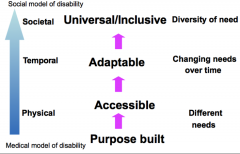
|
|
|
From the Grey et al. (2003) reading, identify 4 barriers and facilitators to participation |
Built environment = barrier Products and tools = facilitator Personal support = facilitator Social institutions and social cultural norms = barrier |
|
|
Identify facilitators and barriers of the built environment for people with a hearing impairment and how these would impact participation |
Facilitator: clear signage Barrier: front desk staff unable to use signlanguage |
|
|
Identify facilitators and barriers of the built environment for children and young people with autism and how these would impact participation |
Facilitator: Separate calming room Barrier: Loud environments |
|
|
Draw and explain or describe how disability discrimination in one area has a flow on effect to another |
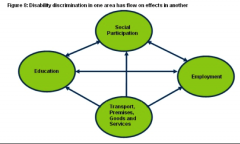
|
|
|
Describe the National Disability Strategy (2010-2020), including its purpose and 3 key policy/priority areas |
A 10-year national plan for improving life forAustralians with disability, their families, and carers. Its vision is for aninclusive Australian society that enables people with disability to fulfiltheir potential as equal citizens. It’s purpose is to establish a high levelpolicy framework to give coherence to, and guide government activity across,mainstream and disability-specific areas of public policy. *Pick your favourite* Policy areas - Inclusive and accessible communities: thephysical environment including public transport, parks, buildings, and housing,digital information and communication technologies, civic life includingsocial, sporting, recreational and cultural life - Rights protection, justice, and legislation:statutory protections such as anti-discrimination measures, complaintsmechanisms, advocacy, and the electoral and justice systems - Economic security: jobs, business opportunities,financial independence, adequate income support for these not able to work, andhousing - Personal and community support: inclusion andparticipation in the community, person-centred care and support provided byspecialist disability services and mainstream services; informal care andsupport - Learning and skills: early childhood educationand care, schools, further education, vocational education; transitions fromeducations to employment; life-long learning - Health and wellbeing: health services, healthpromotion and the interaction between health and disability system; wellbeingand enjoyment of life |
|
|
Describe the 5 National Disability Agreement (2009) reform priorities |
- To build the evidence base for disabilitypolicies and strategies - To enhance family and carer capacity - For strategies for increased choice, control,and self-directed decision-making - To maintain innovative and flexible supportmodels for people with high and complex needs - To develop employment opportunities for peoplewith disability |
|
|
Name and describe the four key bodies of the Australian Healthcare system including their key responsibilities |
|
|
|
what responsibilities does the Commonwealth Government have over healthcare |
Australian Government
|
|
|
what responsibilities to the state and territory governments have other healthcare |
primarily responsible for:
|
|
|
what responsibilities does local government have over healthcare |
* environment controls such as: - garbage disposal - clean water - health inspections - May provide home care and personal preventative services, such as immunisation |
|
|
what does the private health sector cover? |
- provides about 1/3 of all hospital beds in Australia - private medical practitioners provide most out-of-hospital medical services and, along with salaried doctors, perform a large proportion of hospital services - private practitioners provide most dental services and allied health serves such as physiotherapy |
|
|
what is the medical aids subsidy scheme? - including the aim of the service, who it is provided for and what services are provided |
Subsidy funding for medical aids and equipment is available to eligible Queenslanders with permanent/stable conditions or disabilities. Aids and equipment are subsidy funded either on a permanent loan basis, private ownership or through the supply of consumables. incl. Communication aids, continence aids, daily living aids, home oxygen, medical-grade footwear, mobility aids, spinal and lower limb orthoses, artificial limbs, spectacles In general, clients may be eligible for assistance under MASS if they:
|
|
|
what is the national disability insurance scheme? - including the aim of the service, who it is provided for and what services are provided |
|
|
|
what is the better start initiative? including the aim of the service, who it is provided for and what services are provided |
Better Start for Children with Disability (Better Start) |
|
|
Identify two (2) populations who are excluded/ have problems accessing health care and explain the context for these gaps occurring (consider the physical, societal, financial etc contexts) |
rural communities
- less specialists - distance - financial implications and employment and family obligations to be at home neglected children - limited independence requiring support of carers - limits care and access to healthcare with broader future implications |
|
|
Considering all aspects of the environment, identify and discuss the barriers for transport for wheelchair users from where you live if you were going to a:
* Shopping centre * Catching a plane to another Australian city |
shopping centre - airports - taxi: having to order an accessible version - support: |
|
|
Discuss how accessibility compares for people with a mobility impaired versus people with a cognitive impairment
|
x |
|
|
Identify existing actions and new initiatives/ extension in Brisbane that assists with pedestrian mobility and transport
|
State and Territory governments are responsible for public transport and passenger legislation and regulations, and they are also the major providers and/or operators of public transport. Legislation * The Queensland Government's Department of Transport and Main Roads released Moving People Connecting Communities: A Passenger Transport Strategy for Queensland 2007-2017, which sets the direction and shapes the future for moving people and connecting communities in Queensland. * It has also released the Disability Services Plan 2011-2014, and in 2012 the Translink Transit Authority Public Transport Infrastructure Manual, which includes an extensive chapter in Supporting Access Infrastructure. Trains * most trains have full access or assisted access for people with disability *GC light train accessible buses * Around 85% of Brisbane Council's bus fleet (1006 in number) are wheelchair accessible. These buses have ramp systems, level access through the front door and two wheelchair spaces. * millions of dollars in funding provided by Qld Gov to assist councils *100% accessible buses and stops - deadline by 2020 |
|
|
Name two services available to a person to assist with transport (e.g. VOSS, Taxi subsidy scheme) and answer the following questions:
* how are these service facilitators to participation * Identify and discuss limitations to these services |
Vehicle Options Subsidy Scheme (VOSS) * The Vehicle Options Subsidy Scheme (VOSS) offers subsidies to assist people with a disability to buy and modify private vehicles. The scheme provides financial assistance towards: * purchase of a private vehicle (already modified or suitable to be modified) * private vehicle modifications or accessories * driver training * detailed assessment and prescription by a registered VOSS prescriber. You can choose to apply either as a driver or as a passenger in a car driven by a family member or carer. Limitations: * must be under 65years * If your vehicle or modifications cost more than the subsidy amount, you will need to pay the extra money. * VOSS does not cover motor vehicle repairs, ongoing running or maintenance costs. * You are not eligible if you are entitled to assistance from other government-funded programs, or compensation related to your disability. Taxi subsidy scheme * The Taxi Subsidy Scheme (TSS) subsidises taxi travel—half of the total fare, up to a maximum of $25 per trip—for people with severe disabilities. * can be for permanent or temporary disabilities * covers physical, vision, epilsepsy, intellectual impairment, severe emotional and behaviour disorders Limitations * maximum of $25 per trip * for intellectual, emotional and behaviour disorders - must be accompanied by another person at all times |
|
|
Utilizing the course content (lecture slides, tutorial materials and readings) identify some housing problems faced by people with a disability and describe how these problems may impact on occupational participation and engagement |
* More likely to rent from a state or territory housing authority (7%) compared to people without disability (1%). * UN CRPD - The rights prescribed in the Convention are extensive and include the right to live in the community and participate in public and cultural life. * Under-supply, particularly affordable rentals. Purchase an existing home * Difficult to find existing housing that is appropriate * Modification is costly. Build a New Home * Difficult to find developers, designers and builders who understand housing requirements of people with disability. * Generally ad hoc approach of customising existing plans (expensive). General Issues
General Challenges
|
|
|
Explain the positives and the negatives (be sure to include human rights and inclusivity)
of Group homes |
x |
|
|
Explain the positives and the negatives (be sure to include human rights and inclusivity) of segregated housing |
x |
|
|
Describe the Disability Standards for Education, including its purpose and the obligations educators have under these standards
|
Developed to make rights and responsibilities in education and training (obligations under the DDA) easier to understand.
The Standards seek to ensure that students with disability can access and participate in education on the same basis as other students. On the same basis = a student with disability must have the same opportunities and choices which are comparable with those offered to other students, includes: - admission or enrolment - participation - use of facilities and services applies to government and non-gov education and training providers - three obligations: 1. consult 2. make reasonable adjustments 3. eliminate harassment and victimization
|
|
|
Describe how the Australian Disability Clearinghouse and Education and Training website (ADCET) might be utilised by schools
|
In order to facilitate successful outcomes and improve the educational experience for students with disability, ADCET provides information, advice and resources to disability practitioners, academics, teachers and students on inclusive practices within the post-secondary education sector.
MORE SPECIFIC EXAMPLES REQUIRED |
|
|
Describe 'workplace adjustments' and provide three examples of a workplace adjustment that could be made to someone with a disability
|
If a person with a disability isthe best person for the job then the employer must make workplace changes or"workplace adjustments" if that person needs them to perform theessential activities of the job. Examples: • Changing recruitment and selection procedures: providingan Auslaninterpreter. • Modifying work premises: making ramps, modifyingtoilets, providing flashing lights to alert people with hearing loss. • Changes to job design, work schedules or other work practices:swapping some duties among staff, regular meal breaks for a person withdiabetes. • Modifying equipment: lowering a workbench orproviding an enlarged computer screen. •Providing training or other assistance: induction programs for staffwith disability and co-workers. |
|
|
Describe the following employment services, systems or policies. In your description refer to which chapters of the environment from the OCF are addressed and how they are working towards enhancing participation - wage subsidy scheme |
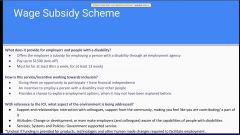
|
|
|
Describe the following employment services, systems or policies. In your description refer to which chapters of the environment from the ICF are addressed and how they are working towards enhancing participation - employment assistance fund |
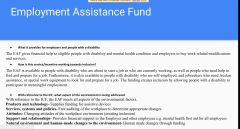
|
|
|
what UN human rights convention article discusses transport? |
article 9 - accessibility people should live independently and participate fully in all aspects of life. state parties should take appropriate meausres to ensure to persons with disability access on an equal basis to others.. to transportation. |
|
|
which of the UN human rights convention article discusses housing? |
article 9 - accessibility people should live independently and participate fully in all aspects of life. state parties should take appropriate measure to ensure to persons with disability access on an equal basis to others.. shall apply to housing article 28 - adequate standard of living and social protection the right of persons with disabilities to an adequate standard of living for themselves and their families, including adequate food, clothing and housing, and to the continuous improvement of living conditions, and shall take appropriate steps to safeguard and promote the realization of this right without discrimination on the basis of disability. includes: - clean water and services - access to public housing programmes - retirement programmes - in particular women and girls with disabilities and older persons with disabilities, to social protection programmes and poverty reduction programmes - respite care |
|
|
what are the four options for housing for people - not including deinstitutionalization? |
* Public housing - state govt maintains * Community housing * Family home * Private rental |
|
|
what does the Housing Act 2003 – Qld cover? |
Establishesthe role of the State Govt inproviding housing assistance to people with a housing need – including publichousing and other housing services. Covers eligibility, type of housing and location. Aimsto: 1.Improve access to safe, secure,appropriate and affordable housing 2.Help build sustainablecommunities |
|
|
what does Housing and Homelessness Services- Qld do? |
Aims to improve access to safe, secure, appropriate and affordable housing. * delivers traditional housing assistance - through grants and social housing - help people access sustain housing in the private rental market, through bond loans, rental grants, RentConnect, the NRAS and the Tenant Advice Network Queensland (TANQ). * influences the development of an effective and responsive housing system through education and partnerships with industry |
|
|
What is the Housing 2020 strategy? |
|
|
|
What are the three main aims that the department of housing works towards |
|
|
|
What does the Nation BuildingEconomic Stimulus Plan aim to do? |
* funding for construction of social housing inc. universal design elements * repairs and maintenance to existing social housing dwellings |
|
|
What is the National Rental AffordabilityScheme (NRAS)? |
Objectives 1.Stimulatesupply of up to 50,000 new affordable rentals. 2.Reducerental costs for low and moderate income households 3.Encourageinvestment and innovation in affordable housing. D3 |
|
|
What is the funding model of the NDIS? |
The individualized funding model, which is at the heart of the National Disability Insurance Scheme (NDIS), involves allocating funding directly to an individual so they can choose the supports necessary to meet their disability related support needs. |
|
|
what UN article of human rights covers education? |
article 24 States Parties recognise the right of persons with disabilities to education, and provides that with a view to realising this right, without discrimination and on the basis of equal opportunity, States Parties shall ensure an inclusive education system at all levels. States Parties shall enable persons with disabilities to learn life and social development skills; shall take appropriate measures to employ teachers including teachers with disabilities who are qualified in sign language and/or Braille and to train professionals and staff; and shall ensure that persons with disabilities are able to access general tertiary education, vocational training, adult education, and lifelong learning. |

